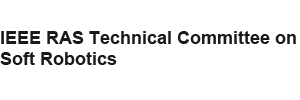Highlighted News
* IEEE ICRA 2015 Workshop on Soft robotics: Actuation, integration, and applications – Blending research perspectives for a leap forward in soft robotics technology
* Robosoft, a Coordination Action for soft robotics, was featured in the November 2014 edition of the Future & Emerging Technologies Newsletter
* Reminder – the current issue of Soft Robotics is already online:
- Editorial – A confluence of technology: Putting biology into robotics
- Roundtable discussion – How does soft robotics drive research in animal locomotion?
- Bioelectrical mechanisms for programming growth and form: Taming physiological networks for soft body robotics
- Robotic granular jamming: Does the membrane matter?
- Soft robotics education
- A resilient, unethered soft robot
- The soft robotics tookit: Shared resources for research and design
New Videos
* Robot Startup Series #7: Interview with Soft Robotics’ Carl Vause
Published Journal Articles
* Soft locomotion, compliant locomotion:
- Neuromechanical control for hexapedal robot walking on challenging surfaces and surface classification (Robot. Auton. Syst., Dec. 2014)
- Bioinspired legged-robot based on large deformation of flexible skeleton (Bioinspir. Biomim., Nov. 2014)
- An experimental and three-dimensional computational study on the aerodynamic contribution to the passive pitching motion of flapping wings in hovering flies (Bioinspir. Biomim., Nov. 2014)
- Torsional locomotion (Proc. R. Soc. A, Nov. 2014)
* Soft sensing, artificial skin, electronic skin:
- Wearable soft sensing suit for human gait measurement (Int J. Robot. Res., Dec. 2014)
- Nonlinear bending models for beams and plates (Proc. R. Soc. A, Nov. 2014)
- Soft two-degree-of-freedom dielectric elastomer position sensor exhibiting linear behavior (IEEE-ASME T. Mech., Oct. 2014)
* Soft human-robot interaction:
- Development and control of a series elastic actuator equipped with a semi active friction damper for human friendly robots (Robot. Auton. Syst., Dec. 2014)
* Soft robot application:
- More is not always better: modeling the effects of elastic exoskeleton compliance on underlying ankle muscle–tendon dynamics (Bioinspir. Biomim., Nov. 2014)
- Learning by imitation with the STIFF-FLOP surgical robot: a biomimetic approach inspired by octopus movements (Robotics Biomim., Oct. 2014)
- Development of haptic devices using flexible sheets for virtual training of abdominal palpation (Adv. Robotics, Oct. 2014)
* Morphological computation, morphological change, self-organization:
- Multiscale tunability of solitary wave dynamics in tensegrity metamaterials (Appl. Phys. Lett., Dec. 2014)
* Soft matter electronics, stretchable electronics:
- Energy harvesting with stacked dielectric elastomer transducers: Nonlinear theory, optimization, and linearized scaling law (Appl. Phys. Lett., Dec. 2014)
* Biological studies:
- Intrinsic variability in shell and soft tissue growth of the freshwater mussel lampsilis siliquoidea (PLoS ONE, Nov. 2014)
Popular Articles
- Touch sensors can now mimic our skin’s detection of stretching and twisting (Scientific American, Dec. 2014)
- Artificial muscles that remember (IEEE Spectrum, Dec. 2014)
- Stretching when zapped by an electric current, muscle chains could mobilize microbots (Kurzweil AI, Nov. 2014)
- 3D printed robots teach themselves to move (IEEE Spectrum, Nov. 2014)
- Video Friday: Real Big Hero, robots 3D, and Chappie trailer (IEEE Spectrum, Nov. 2014)
- Beautiful fluid actuators from Disney Research make soft, safe robot arms (IEEE Spectrum, Oct. 2014)
Book
* Opinions and outlooks on morphological computation:
- Extracting the full power of morphological computation: Lessons from case studies of robots under decentralized control
- A reservoir computing view of morphological computation
- Deep into morphology: Emotions and functional structure
- Zen, robotics and the art of pushing swing
- A virtual material approach to morphological computation
- A review of morphological computation from a perspective of heterarchy
- Morphological computation and heuristic bio-robotics
- Morphology: A concrete form of intelligence
- Molecules and robots
- Morphological computation: A perspective based on bacterial movement
- Morphological computation with hydrostatic interaction between mechanosensory oscillators
- Evolving morphological computation
- A morphological viewpoint: Juxtaposition of design approaches for locomotion-rehabilitation robotics
- Morphological computing and design
- Morphological computation at the molecular scale
- Morphological computation – A broad perspective
- Trade-offs in exploiting body morphology for control: from simple bodies and model-based control to complex bodies with model-free distributed control schemes
- Morphological control as guiding principle in physiology and medical applications
- The morphological computation principles as a new paradigm for robotic design
- Morphological computation – The body as a computational resource
